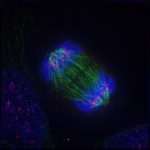Definition
noun
The third stage in meiosis II after prophase II, and highlights the separation of the sister chromatids of each chromosome towards the opposite ends of the cell
Supplement
Meiosis is a reproductive cell division since it gives rise to gametes. The resulting cells following meiosis contain half of the number of the chromosomes in the parent cell. That is because the parent cell undergoes two meiotic divisions called first meiotic division (meiosis I) and second meiotic division (meiosis II). Each of them has four major phases. These are prophase, metaphase, anaphase and telophase. Each of these phases is designated as I or II depending where it occurs, i.e. in meiosis I or in meiosis II.
Anaphase II is the third stage in meiosis II. It is the stage after metaphase II, which is that phase wherein the chromosomes are at the equatorial plane and spindle fibers are attached to the kinetochores. Anaphase II is the stage when sister chromatids of every chromosome separate and begin to move towards the opposite ends of the cell. The separation and the movement is due to the shortening of the kinetochore microtubules. Anaphase II precedes telophase II.
Meiotic anaphase II is similar to the anaphase in mitosis. Both mitotic anaphase and meiotic anaphase II involves the separation of sister chromatids towards the opposite poles of the cell. In anaphase I, the paired homologous chromosomes are the ones separating from each other; as a result, the sister chromatids remain together.
See also:
- meiosis I
- anaphase
- homologous chromosome
- centromere
- kinetochore
- sister chromatids



